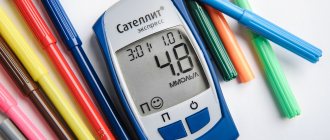An endocrine-type disease characterized by complete insulin deficiency is called diabetes mellitus. Increasing the production of glucose in the blood entails a lot of problems leading to death. It is important to identify the signs of diabetes in women in the early stages. Then it becomes possible to start treatment on time and avoid complications.
What symptoms will indicate the onset of the development of this disease? We list the main problems that you should pay attention to:
- Serious weight loss for no apparent reason. This is due to a violation of proper metabolism in the body.
- Gaining excess weight with a normal diet. A similar case may occur with other serious deviations.
- Constant feeling of thirst. A person drinks a lot of water, but cannot get rid of dry mouth.
- Hunger. Despite eating regularly, the body cannot absorb nutrients and requires a snack even immediately after eating.
- Frequent urge to urinate. In this way, the body tries to cope with excess glucose.
- Vision pathologies, retinal dissection and blurred vision before the eyes.
- Mycoses and thrush that cannot be treated.
Causes of female diabetes mellitus
The main reason for the development of the disease is genetic predisposition.
If the parents suffered from high blood sugar, the child will inherit this unpleasant pathology. You can identify the presence of genes with a deviation marker using DNA analysis. A test conducted in our laboratory will help determine whether you are at risk of insulin deficiency. This will make it possible to start therapy as early as possible and stop the development of the disease. There are other factors that provoke diabetes:
- Having excess weight. Excessive fat mass disrupts metabolism and acts as a guardian of possible pathologies.
- Infectious pathologies.
- Stress and overwork. This factor is especially dangerous for women over 30.
- Bad habits, especially smoking. Resins contaminate blood vessels and interfere with the normal functioning of the circulatory system.
Manifestation of diabetes in the early stages
The peculiarity of this disease is that external signs may not appear for several years after the onset of development. This leads to the fact that the pathology manages to cause significant harm to the body before treatment begins. It is important for women to be able to identify subtle signals of distress in the body.
You should definitely consult a doctor if you notice the following signs:
- Decreased performance and fatigue. Moreover, this condition does not go away even after proper rest.
- Attacks of drowsiness and lethargy that regularly occur after eating.
- Persistent dry mouth. This is the main and practically the first sign of diabetes in women. Can't quench your thirst no matter how much you drink? You need to see a doctor urgently.
- Rapid weight loss, in which you constantly feel hungry and can eat quite a lot.
- Itching and ulcers on the skin, wounds whose origin you cannot explain.
Drug treatment
The current concept of treatment for type 1 diabetes involves injections of insulin, which is produced by the pharmaceutical industry in the form of pen syringes.
The injection regimen consists of two parts:
- injection of a long-acting hormone under the skin for 12–24 hours (administered 1–2 times a day), which covers the body’s need for insulin at night and between meals;
- introduction of “ultra-short” insulin or, as it is also called, insulin “for food”. It is used after meals or when signs of unwellness to reduce excessive glucose increases1
In the treatment of type 2 disease, insulin is rarely used, only if other approaches are ineffective. In both cases, patients take additional glucose-lowering drugs, as well as medications that prevent the development of possible complications 3.
Symptoms of diabetes in women
Pathology is divided into two types. The first is called the insulin-dependent stage. It is typical for people over 30 years old. At this age, the disease develops very quickly and symptoms appear almost instantly. The presence of elevated glucose levels indicates:
- Sudden weight loss and associated weakness.
- A constant desire to drink, leading to an increased urge to urinate.
- Feeling of a metallic taste in the mouth and dry mucous membranes.
- Frequent headaches, nervousness.
- Muscle pain and spasms.
The second type is more severe.
It is difficult to treat, especially if there is a tendency to form the disease. This stage is characterized by symptoms such as:
- Serious decrease in immunity. Severe colds.
- Increased appetite leading to weight gain. Compulsive overeating.
- Increased hair loss.
The first signs of type 2 diabetes
Although doctors have been saying for years that preventive screenings are a chance for early detection of the disease or prediabetes, patients rarely follow these recommendations. For this reason, the disease is often diagnosed at a late stage.
This is also because the symptoms of type 2 diabetes are quite varied and at the same time not very specific. The disease can develop undetected for many years. Therefore, it is worth carefully monitoring your health and quickly responding to suspicious symptoms.
Symptoms in pregnant women
It is very difficult to track how diabetes mellitus begins in pregnant women. Hormonal changes in the body make it difficult to determine the presence of abnormalities using tests. Glucose and insulin levels fluctuate within normal limits at this time. But already from the second trimester it becomes clear whether there is pathology. It is during this period that the level of danger is determined. The main external sign indicating the development of the problem is a sharp deterioration in vision.
During the development of this pathology, the condition of the genitourinary system worsens. Exacerbation of infectious diseases of this type occurs even with absolute hygiene. High blood pressure that does not return to normal for a long time will also indicate the presence of problems. Impaired protein synthesis leads to the formation of these elements in the urine. If a girl is registered with a gynecologist, she undergoes tests regularly. This helps to identify abnormalities in time and begin therapy. But for those who neglect going to the doctor, there is a high probability of not recognizing the onset of trouble.
Diagnosis of the disease
At the initial stage, diagnosis consists of laboratory tests. First of all, a general analysis of urine and blood is performed. A biochemical blood test is also performed, which determines the quantitative content of glucose, urea nitrogen, metabolic products - creatinine and electrolytes, gas composition is determined, etc. 3.
The composition of urine is tested for the presence of ketone bodies. If any are detected, their presence in the blood serum is determined.
Additional examination methods can be used to diagnose the disease:
- electrocardiography of cardiac muscle activity;
- chest x-ray;
- analysis of biological material of body fluids.
Features of the course in girls
Statistics show that women are much more likely to suffer from the manifestations of pathology.
This especially applies to the second type of disease. This is due to the fact that the weaker sex has more adipose tissue, and, on the contrary, less muscle mass than men. The fact is that adipose tissue does not absorb insulin and does not utilize glucose well. Girls are also more susceptible to stress, which provokes the release of steroid hormones and increased glucose levels. A particular danger in the development of pathology is the love of sweets. Frequently eating cakes and pastries leads to an increase in fat. This leads to activation of the disease in women. Girls also develop another type of pathology - gestational. But we'll talk about it later.
Normal blood sugar levels in men
As a screening, the level of glucose in the serum of capillary or venous blood is determined on an empty stomach or during the day. [6, 7]
| Index | Normal values |
| Fasting blood glucose (finger prick) | 3.3-5.5 mmol/l |
| Fasting blood sugar (venous blood) | 3.7-6.1 mmol/l |
| Blood glucose at random test during the day | Up to 11.1 mmol/l |
| Glycated hemoglobin | Up to 6.5% |
| Glucose tolerance test | No more than 7.6 mmol/l 2 hours after the “load” of glucose |
Determination of the concentration of glycated hemoglobin and a glucose tolerance test are prescribed in case of questionable screening results to clarify the diagnosis. [6, 7]
Skin manifestations
The course of the disease rarely affects the condition of the skin. However, sometimes changes are observed that indicate problems with glucose production. It is worth paying attention to:
- Peeling and dry skin that were not noticed before.
- Darkening of folds. This is typical for type 2 diabetes.
- Premature aging of the skin. This is due to the fact that pathology can cause aging of the entire organism. This is reflected very strongly on the skin.
Such changes occur very slowly and most people simply do not pay attention to them. It's also worth remembering that these signs may indicate other health problems. It is worth getting tested if you find yourself with similar symptoms. This will help determine the source of the symptoms and eliminate it.
Signs in women over 30
At this age, as a rule, type 1 develops, a rather severe autoimmune disease.
The development and manifestation of the disease occurs rapidly and most often does not depend on the lifestyle of the sick person. This type is considered hereditary. Its development is almost impossible to prevent. Acute symptoms and early signs for this type of disease:
- nausea and vomiting,
- numbness of the limbs,
- smell of acetone from the mouth,
- thirst and hunger.
If you have these signs, you should not hesitate to get tested in the laboratory. However, you can check your sugar level with a home glucometer. However, do not forget that such a check will not give you the complete picture.
Once you are diagnosed with diabetes, do not delay consulting your doctor. You will be prescribed a special diet and treatment that will help eliminate the severe course of the disease and protect you from disability.
Flexibility test
At home, you can conduct a flexibility test, the results of which can determine the presence of diabetes.
Ask your spouse to stand on the floor and try to wiggle their big toes. If each finger is able to rise 50–60° from the floor, that’s good, but if the fingers can only barely lift off the floor, then the metabolism is impaired.
Article on the topic
Fighting diabetes. What is dangerous about sugar disease and how to live with it
Let the husband put his palms together. If the fingers coincide with each other along the entire length, good. In diabetics, only the pads of the fingers are connected because their tendons are shortened.
But, of course, such tests are not comparable in diagnostic importance to blood sugar tests.
Signs in women over 40
After 40 years of age, there is a danger of developing both type 1 and type 2 disorders. The main reasons for developing this pathology are a sedentary lifestyle and overeating. The autoimmune system begins to attack the pancreas, where insulin is produced. It's not known why, but thin women have a higher risk of developing diabetes without actively developing symptoms.
Insulin injections are rarely required. The main focus of treatment is on a low carbohydrate diet. A healthy lifestyle will help support the body in the fight against the problem. The main thing is not to get caught up in unhealthy sweets and other temptations. Otherwise, all previous treatment will go to waste.
Bibliography
- Dedov I.I., Melnichenko G.A. Endocrinology. National leadership. M.: Geotar-Media, 2013.
- Dedov I.I., Shestakova M.V. Clinical recommendations “Algorithms for specialized medical care for patients with diabetes.” 7th issue. M.: Ministry of Health of the Russian Federation Russian Association of Endocrinologists Federal State Budgetary Institution Endocrinological Research Center, 2015.
- Kholodova E.A. Clinical endocrinology. Guide for doctors. M.: Medical Information Agency, 2011.
Author:
Baktyshev Alexey Ilyich, General Practitioner (family doctor), Ultrasound Doctor, Chief Physician
Signs in women over 50
Typically, menopause begins at age 50 or older. It disrupts the metabolism in the body, provokes obesity and problems with the cardiovascular system. Also, changes in hormones lead to irritability and stress, which negatively affects the immune system.
This period of life is characterized by the development of type 2. It can be hidden, and you will not understand what signs may indicate the development of the disease. It is important to undergo timely examinations and tests to identify possible problems. This especially applies to those whose parents and other relatives suffered from this disease.
By the way
There is an opinion that people with a sweet tooth are primarily susceptible to diabetes. But in fact this is a myth. Excessive consumption of sweets does not lead to diabetes. But it can lead to obesity, and this is a real risk of developing diabetes. Therefore, it doesn’t matter what exactly a person overeats - pies and buns or sausages and pates, the result can be the same.
For prevention, every middle-aged and older person should reduce the amount of easily digestible carbohydrates and fats in their food. It is useful to eat more vegetables and unsweetened fruits, as well as foods rich in vitamins C, B, PP, E. And, of course, you should not smoke.
How to protect yourself from diabetes
Prevention of the development of increased glucose production is quite simple. You need to follow a few tips:
- Lead an active lifestyle. If you have a sedentary job, take long walks in the evenings. Give up weekends spent on the couch watching TV. This is especially true for overweight people.
- Proper nutrition. Skip sweet baked goods in favor of whole grain ones. Add light protein foods to your diet, try not to eat foods with complex carbohydrates. Convenience foods and fatty foods are your main enemies.
- Avoid stress. Learn to protect yourself from factors leading to grief and worry. Learn to avoid negative emotions and don't allow yourself to get angry too often.
- Monitor your blood pressure closely. Frequent pressure changes lead to weakening of blood vessels and the entire body.
- Find out if you are predisposed to this disease in advance using DNA testing.
Consequences of diabetes in women
Without timely treatment, you risk getting serious complications, getting rid of which will be extremely difficult. The main dangers plaguing diabetics who do not adhere to doctor’s recommendations are:
- Constant swelling. Persistent swelling throughout the body is a consequence of excessive fluid retention in the body.
- Trophic ulcers. They are characteristic of a long course of the disease, which did not respond to appropriate treatment.
- Gangrene. Damage to the blood vessels of the extremities results in amputation. This outcome is typical for an advanced form that has been going on for many years.
- Coma. An extremely rare consequence of a severe form of the disease. This state is preceded by clouding of consciousness and loss of a sense of reality.
Diagnosis of diabetes in the clinic
Today, diabetes can be diagnosed in any clinic. The doctor will prescribe a series of tests to help determine your glucose level, the possible stage of the disease and the characteristics of your body.
- Blood and urine analysis. Shows your glucose level and helps guide you on the right diet to prevent disease.
- Analysis for glycosylated hemoglobin. Helps recognize fluctuations in blood sugar levels.
- Glucose tolerance. Determines the presence of disease and the level of insulin sensitivity.
Type 2 diabetes – what is it?
The content of the article
The most common form of diabetes is type 2 diabetes, also called adult-onset diabetes or non-insulin-dependent diabetes. The dominant symptoms of this disease are abnormal blood glucose levels accompanied by insulin resistance.
With insulin resistance, the body produces a lot of this hormone, but the tissues are less sensitive to its effects.
Genetic predisposition, as well as modifiable factors, that is, those that we influence, are responsible for the development of the disease. Although the tendency to develop the disease is hereditary, diabetes can be caused by an unhealthy lifestyle.
Abdominal obesity contributes to the development of insulin resistance, as well as:
- increased levels of triglycerides and cholesterol;
- hypertension;
- low physical activity;
- age (the risk of developing the disease increases with age);
- chronic sleep disorders;
- past gestational diabetes;
- smoking and drinking alcohol.
Low physical activity
Genetic factors and a family history of type 2 diabetes increase the risk of developing this disease. The Diabetes Association recommends that people at risk should be screened annually for diabetes. Healthy people over 45 years of age should do this once every three years.








